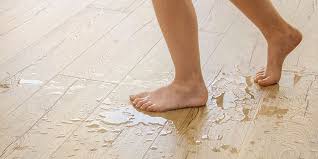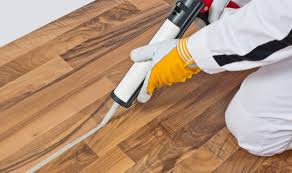Is laminate waterproof?
We are often asked is laminate flooring water resistant. The answer is yes and no. With new laminate technology, many manufacturers are now offering water resistant and waterproof laminates that can withstand spills and surface moisture.
With a traditional laminate without waterproof coatings, most surface spills can be wiped up quickly and will not cause any harm, however if spills are allowed to soak into the joints of the laminate, major issues can occur.
Traditional Laminate Flooring Is Water Resistant
If you are worried about your pets or kids destroying your laminate flooring, due to spilling drinks, or potty accidents, don’t worry too much. Laminate flooring is recognized to be one of the most pet and kid friendly flooring solutions on the market. Accidents can be cleaned up easily with little repercussion, so long as you get to them quickly.
Traditional Laminate Flooring Is Not Water Proof
Water resistance should not be confused with waterproof. Waterproof means water will not be able to permeate the surface of the object. While water resistant means the object will resist, though does not entirely prevent the penetration of water.
If you leave a spill unattended on a laminate flooring, you will be sorry you did it. What happens is the spill will seep into the locking system and cause the edges of the laminate to cup or buckle, ultimately ruining your floor.
You can mitigate some of this risk, however. In areas with a high risk of moisture exposure, such a bathroom, laundry room, or kitchen, it is recommended to glue the joints in between planks. This will create a more moisture resistant surface.

Why Laminate Flooring Isn’t Waterproof
The reason moisture is such a problem for laminate flooring has to do with its construction—in particular, its seams and its fiberboard core.
The problem that water creates for laminate flooring is not with the top layer, but with the core, which is little more than a dense type of fiberboard—an engineered product made from wood fibers. If you’ve ever seen a sheet of particleboard in the rain, you’ll know how it bubbles up and crumbles like a wet soda cracker. Complicating the issue is the click-and-lock joining system used in laminate flooring, which makes it difficult to create perfectly tight seams. Seam gaps plus a fiberboard core equals a flooring that will swell and delaminate when water seeps past the surface layer.
One little-known aspect of this moisture-and-laminate issue is that the moisture problem actually starts in the factory, not in the home. Flooring manufacturers have found that high moisture content in the fiberboard particles in the factory can result in poor adhesion of the top melamine wear layer.

Waterproof Laminate Flooring Review: Pros and Cons
Pros
- More resistant to moisture than standard laminate flooring
- Resists scratches better than vinyl
- Easy DIY installation
Cons
- Usually not truly waterproof
- Style and color choices are limited
- Considerably more expensive than standard laminate flooring

How To Make Your Laminate Flooring Waterproof
If you are dealing with a moisture problem, you should first go to the flooring company that installed your floor and ask them if they have a sealant that is specific to your laminate floor. Using a trustworthy brand that was made specifically for your floor will yield the best results and will maximize longevity.
After you have talked with the flooring company who installed your floor, here are several tips for preventative waterproofing care:
- Use Silicone To Prevent Water Damage
Another easy way to prevent water damage to your laminate floor is to use a silicone caulking gun to fill any cracks where water could drain into and cause damage. We recommend using DAP Silicone Plus, which is a highly rated silicone sealant with clear instructions on how to use it.
Prevention by making your floor water-resistant is almost more important than repairing, as it is far easier and will save you time and money in the long run.
- Have a High-Quality Top Coat Applied To Your Laminate Floor
Even though this may seem like an additional step, it is entirely worth it in ensuring the longevity of your laminate floor. Applying a top coat to your laminate floor involves treating the entirety of the floor.
Unlike silicone caulking which simply protects target areas of your floor from damage, coating your laminate floor involves covering the entire surface with polyurethane. Polyurethane protects the surface as well as the cracks of your laminate floor which will increase longevity and water resistance.
One thing to be aware of if you are considering coating your laminate floor is that generally laminate floors require two layers of coating to make them impervious to water damage. Failing to apply the adequate amount of coating layers to your floor will not yield the same results.
Tips for Maintaining Laminate Flooring?
Joints, click and lock seams are the main hindrance to the waterproof floor. This provides a weak point for water to sip to the subfloor.
- Clean all debris and dirt before installing it. Take more care on the corner and edges of laminate floors.
- Consider applying epoxy glue on the outer edges and press it down to firmly seal it. Allow it to dry completely.
- Cover the edges and apply floor sealant on your laminate floor. allow it to dry. You may apply a second and third layer for better results. Allow each layer to dry completely before applying the next one.
- You may also consider luxury vinyl plank as an alternative for your waterproof floor needs.